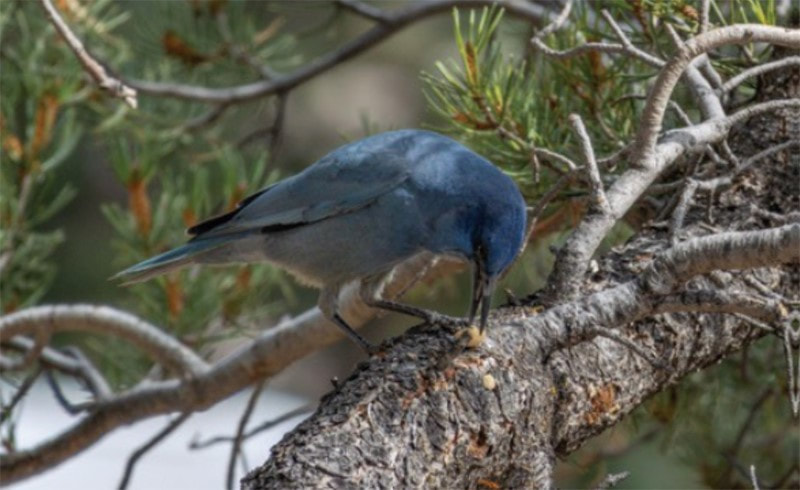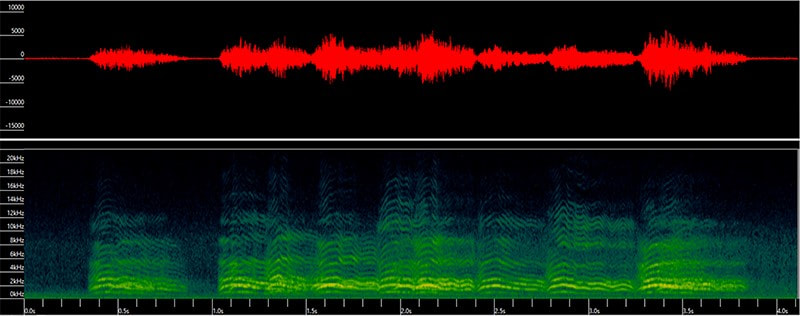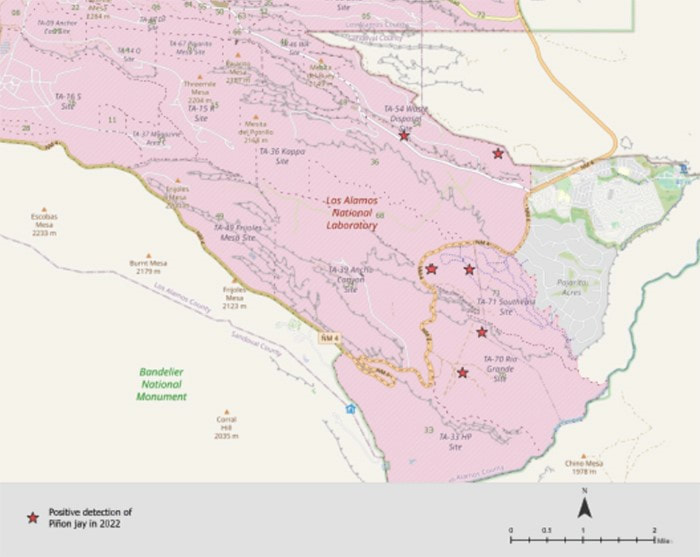|
Courtesy of the Los Alamos Reporter Biologists from Los Alamos National Laboratory have been collecting birdsong audio files from the pale blue, long-billed bird that relies heavily on piñon-juniper woodlands, a prevalent habitat on Lab property. The efforts to monitor the pinyon jay, a native New Mexican species in decline, are to better understand its on-site presence and avoid impacts to the Lab’s mission deliveries. It's also part of the Lab's responsibility to steward its natural resources. The jay lives in groups of 50 to 300 and forms smaller colonies of lifelong nesting pairs during the breeding season. A single bird may collect and cache as many as 2,600 piñon seeds from their estimated 15- to 25-square-mile home range. With impeccable spatial memory, pinyon jays return to their hidden seed caches year after year. As they move about, jays disperse seeds that help sustain piñon tree regrowth, creating a continuous cycle of a healthy piñon pine ecosystem. Unfortunately, scientists estimate pinyon jay populations have declined approximately 85% between 1970 and 2014 due to a variety of environmental and anthropogenic impacts, according to the landbird conservation network Partners in Flight. "There's an incredible amount of uncertainty regarding the pinyon jay," said Ethan Ditmanson of the Lab’s Environmental Stewardship group. "By collecting data and information, we can minimize that uncertainty and better understand potential impacts to operations relative to an Endangered Species Act listing." The jay was petitioned by wildlife advocates in April 2022 for listing under the Endangered Species Act. The U.S. Fish and Wildlife Service is currently following its regulatory procedure to review the petition, and will ultimately determine whether the jay warrants federal protections. In November 2022, Lab biologists began a sitewide pilot monitoring study of the pinyon jay to understand what areas of the Department of Energy’s property the jays use for breeding and seed caching. Biologists are also identifying how Lab operations may be affecting the species, as well as potential impacts to Lab operations from an Endangered Species Act listing. The study began with biologists deploying autonomous recording units in suitable habitat around the Lab, which measures into the 11,000-acre range. They recorded positive jay vocalizations during the breeding and nonbreeding seasons, then followed up on the detections with standardized ground surveys. "We now know that pinyon jays are here year-round, so we are working to develop a better understanding of how they are using the landscape at LANL," said Jenna Stanek, also of the Environmental Stewardship group. "Such understanding will help ensure a beneficial balance between mission operations and compliance if the jay does receive federal protections." "Proactively monitoring this species will help us prepare for an Endangered Species Act listing, potentially minimizing operational impacts like timing delays and geographic access limitations, while also protecting the pinyon jay on Lab property," added Audrey Sanchez from Environmental Stewardship. The Lab is currently home to three animals protected under the Endangered Species Act: the Mexican spotted owl, Jemez Mountains salamander and southwestern willow flycatcher. Compliance requirements often result in additional project planning considerations and constraints, and the Lab works to balance operations and development while preventing adverse impacts to federally listed species. "We are fortunate to have such a diverse and rich ecosystem that supports many species," said Jenette Hyatt, senior director for the Lab's Environment and Waste Programs. "To me, it's reassuring that the manner in which we execute our mission is being reviewed to understand our impact on the natural environment and ensure the beauty and benefit of the LANL ecosystem endures for generations to come."
0 Comments
Northern New Mexico College demonstrates commitment to becoming a learning environment where Latino and all students thrive
ESPAÑOLA, N.M. — Excelencia in Education, the nation’s premier authority on efforts accelerating Latino student success in higher education, announced today that President Hector Balderas of Northern New Mexico College has chosen to affiliate with the national network of Presidents for Latino Student Success (P4LSS). The network comprises a group of presidents and chancellors who have committed to making their campuses learning environments where Latino and all students thrive. Excelencia formed their network of common cause in 2011 and Presidents for Latino Student Success in 2014 to support institutional leaders who are transforming higher education to make our country stronger with the contributions, skills and talents of Latino college graduates. Programs and initiatives that work for Latinos support increased attainment for all students. Latinos are a young, fast-growing population, yet degree completion gaps have increased between Latinos and their White peers. Excelencia’s analysis shows that closing the gap in degree completion by accelerating Latino student success will strengthen America’s workforce and civic leadership. Their goal is 6.2 million degrees earned by 2030. Higher Education institutions in the P4LSS network are focused on advancing success for Latino and other low-income and first-generation students. Participants in their network have documented higher retention rates and double the Latino faculty representation found at other institutions. Through the P4LSS network, Balderas will collaborate with Excelencia and other postsecondary leaders to leverage collective expertise and resources, foster partnerships and amplify current efforts to accelerate Latino student success in higher education at the national level. “Institutional leadership focused on intentionally serving Latino, and all, students is the hallmark of the presidents and chancellors in this network," said Sarita Brown, co-founder and president of Excelencia in Education. “We are proud to catalyze and support them as they advance student success and grow talent for our country’s bright future." Balderas joins more than 150 leaders that belong to the P4LSS network and lead the nation in enrolling and graduating Latino students. Although the network represents only five percent of the thousands of colleges and universities across the country, the network enrolls 32 percent and graduates 34 percent of all Latino students in higher education. "It is an honor to join this outstanding group of leaders, who are dedicated to the success of Latino and Hispanic students across the nation," said President Balderas. "As the president of an institution that serves an overwhelmingly Hispanic and Indigenous student population, I am honored to learn and work side by side with this group, as we work to strengthen student success for our communities.” Excelencia is honored to make common cause with the action-oriented, trendsetting presidents and chancellors who have answered their national call to accelerate Latino student success in higher education and ensure America’s future. To learn more about the Presidents for Latino Student Success network and other institutional leaders across the country affiliated with Excelencia, visit https://www.edexcelencia.org/leadership/presidents-latino-student-success. ### About Excelencia in Education: In 2024, Excelencia in Education marks 20 years of service to accelerate Latino student success in higher education by promoting Latino student achievement, conducting analysis to inform educational policies, and advancing institutional practices while collaborating with those committed and ready to meet the mission. Excelencia has established a network of results-oriented educators and. policymakers to address the U.S. economy’s needs for a highly educated workforce and engaged civic leaders. For more information, visit https://www.edexcelencia.org/. About Northern: Northern New Mexico College has served the rural communities of Northern New Mexico for over a century. Since opening in 1909 as the Spanish American Normal School in El Rito, NM, the College has provided affordable access to quality academic programs that meet the changing educational, economic and cultural needs of the region. Northern is an open-admissions institution offering the most affordable bachelor’s programs in the Southwest. Now one of the state’s four regional comprehensive institutions, with its main campus in Española, Northern offers more than 50 bachelor’s, associate, and certificate programs in arts & human sciences, film & digital media, STEM programs, business, education, liberal arts, and nursing. The College has reintroduced technical trades in partnership with two local unions and five public school districts through its new co-located Branch Community College, the first of its kind in the state’s history. Northern is accredited by the Higher Learning Commission (HLC) and has earned prestigious program specific accreditations for its engineering, nursing, education, and business programs. Learn more at https://nnmc.edu/. SANTA FE – The Scientific Laboratory Division of the New Mexico Department of Health (NMDOH) has confirmed the first case of hantavirus pulmonary syndrome (HPS) this year. A man living in San Juan County was hospitalized, released, and is at home recovering.
HPS, however, is often a severe, sometimes fatal, respiratory disease in humans caused by the Sin Nombre virus. In 2023, New Mexico had seven cases of HPS in residents of McKinley, San Juan and Taos counties, with two of these patients dying. In New Mexico, deer mice are the primary carriers of hantavirus. The virus is found in mice droppings and urine, and people are typically exposed to hantavirus around their homes, cabins or sheds, especially when cleaning out or exploring enclosed areas with mouse droppings. “Mice tend to try to enter buildings to find shelter, so it is important to seal up homes and other structures,” said State Public Health Veterinarian Erin Phipps, DVM, MPH. “While there is no specific treatment for HPS, the chances of recovery are better when medical attention is sought early, and the healthcare provider is informed about any environmental contact with rodents.” Symptoms typically develop within one to six weeks after rodent exposure and may look and feel like the flu or a stomach bug. Individuals with HPS may experience fever and muscle aches, possibly accompanied by chills, headache, nausea, vomiting, diarrhea, abdominal pain and cough, which can progress to respiratory distress and severe illness. Avoid exposure to rodents and their nests – and reduce the risk of contracting hantavirus – by following these important steps:
For more information about this virus, including fact sheets in English and Spanish, visit the Department of Health’s HPS webpage |
Abiquiu NewsLocal News Stories Archives
July 2024
Categories |







 RSS Feed
RSS Feed